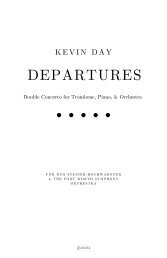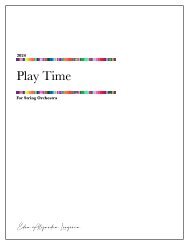Salon Morisot-Jodie Blackshaw
You also want an ePaper? Increase the reach of your titles
YUMPU automatically turns print PDFs into web optimized ePapers that Google loves.
T PROGRAMME NOTES T<br />
"<strong>Salon</strong> <strong>Morisot</strong>" is a suite of three miniatures that are inspired by the remarkable artistry of little known female French impressionist artist,<br />
Berthe <strong>Morisot</strong> (1841-1895). <strong>Morisot</strong> was highly admired by her fellow Impressionist colleagues and her works were exhibited in the very<br />
first (and many consequential) Impressionist ‘<strong>Salon</strong>’ of 1874 (a <strong>Salon</strong> being an exhibition). Many famous artists held an original <strong>Morisot</strong><br />
artwork in their private collections including Manet, Monet, Degas and Pissaro. <strong>Morisot</strong> married Édouard Manet’s younger brother<br />
Eugene Manet and her painting styles are regarded as a driving force behind the Impressionist style.<br />
The three miniatures in this program are inspired by three <strong>Morisot</strong> artworks that depict a particular period in her life.<br />
I – Majesty: inspired by the painting ‘The Harbor at Lorient’ (1869).<br />
The Harbor at Lorient" features <strong>Morisot</strong>’s sister Edma and tall ships. Edma and her sister were very close. She had not long been married<br />
and they missed each other terribly. Hence, I have attempted to capture not only the grandeur of the tall ships but to also reveal the<br />
despair and heartbreak felt by both sisters at this time. It is my desire that the harmonic tensions reveal their hidden emotions whilst<br />
maintaining an element of calm on the surface.<br />
II – Devotion: inspired by the painting ‘The Cradle’ (1873)<br />
This delicate and revealing artwork again features <strong>Morisot</strong>’s sister, but this time in a maternal role with her newly born daughter, Blanche.<br />
At the time this was painted, Berthe <strong>Morisot</strong> was 31 years old and unmarried. In her letters to her sister, Berthe was torn between her<br />
passion for painting and her desire to marry and become a Mother. The tension displayed in this artwork suggest a Mother’s fatigue and<br />
mixed emotions about the daunting task of raising a child. Hence, I have written this work to suggest the cycle of emotions a new parent<br />
feels when their child is born including nervousness, joy, intense love and even a little trepidation. The work begins and ends the same<br />
way to represent this ongoing succession of sensations that can be felt over the course of a day, a moment, a lifetime, as suggested in<br />
the artwork ‘The Cradle’.<br />
III – Enchantment: inspired by the painting ‘The Garden at Bougival’ (1884)<br />
In late 1874 Berthe <strong>Morisot</strong> married Édouard Manet’s younger brother, Eugene. He dedicated his life to Berthe’s painting career, hence<br />
alleviating her mixed emotions about marriage. The ‘Garden at Bougival’ is 11 years on from ‘The Cradle’ and is painted in quite a different<br />
style, reflecting developments in both her professional and personal life. Her painting output was slowed due to the birth of her only child<br />
Julie, in 1878. Berthe <strong>Morisot</strong> and her family loved to holiday in Bougival (25km West of Paris) and between 1881-1884 they rented a<br />
home in the area and spent most of their time there. It was a very happy time for the family, before the decline of her husband’s health<br />
that lead to his premature death in 1892. Hence the final movement in this suite is quite whimsical, reflecting the relaxed emotions<br />
associated with holidays as well as Berthe’s chance to equally indulge in her two passions; family and painting.<br />
vii

















